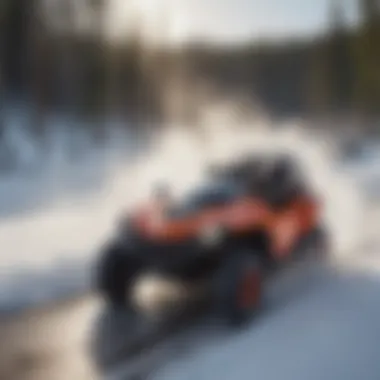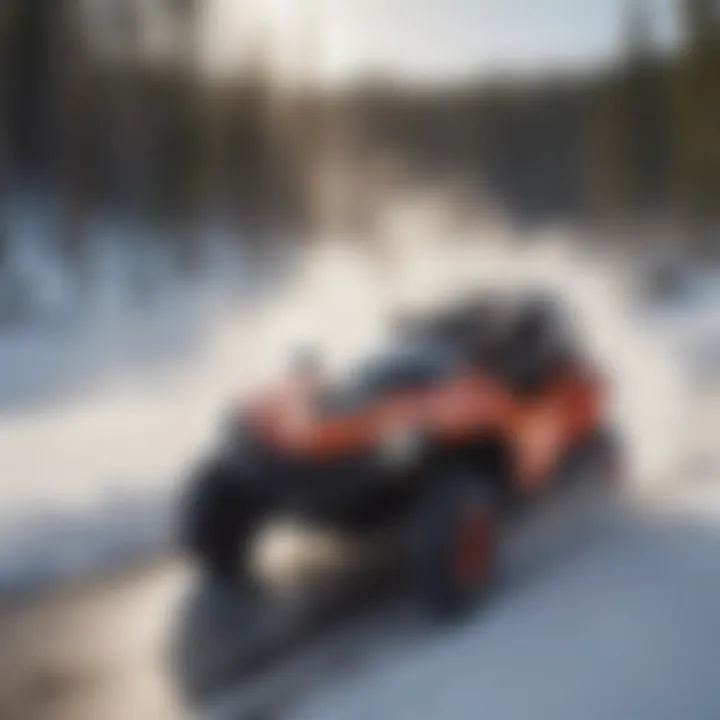Snowmobiling in Yellowstone: A Comprehensive Exploration


Intro
Yellowstone National Park is often celebrated for its stunning landscapes and unique geothermal features. However, beyond its scenic overlay lies a rich tapestry of activities that thrive in the winter months. Snowmobiling, in particular, offers a distinct way to engage with this iconic land. The thrill of gliding across snow-capped trails, while surrounded by the park’s magnificent wildlife and varied terrains, draws enthusiasts each winter.
However, the act of snowmobiling in such a delicate environment raises questions about sustainability and ecological preservation. As we begin our exploration, it is essential to understand the intersection between recreation and conservation. This article will provide insights into historical contexts, relevant regulations, and the ecological impacts of snowmobiling within Yellowstone's expansive wilderness. By blending enthusiasm for winter sports with a conservation-minded perspective, readers can grasp the necessity of balancing adventure with environmental integrity.
Prelude to Snowmobiling in Yellowstone
Snowmobiling in Yellowstone National Park offers unique pathways to engage with one of America’s most iconic landscapes. This activity extends beyond mere recreation; it’s a way to connect with the park's pristine beauty in winter. The importance of understanding snowmobiling in Yellowstone lies in its blend of adventure and responsibility. Enthusiasts should be aware of the historical, ecological, and regulatory frameworks that shape the experience.
Historical Overview
The history of snowmobiling in Yellowstone can be traced back to its introduction in the 1960s. This period marked a shift in how visitors could experience the park in winter. Initially, traditional means, such as cross-country skiing and snowshoeing, dominated winter recreation. However, as technology evolved, machines like the Polaris and Ski-Doo transformed mobility in snowy terrains.
Snowmobiling became popular for its ability to cover vast distances quickly, allowing access to stunning areas that would be difficult to explore otherwise. However, the environmental impact came into focus as visitation increased. Public concern peaked in the 1990s, leading to debates about the balance between recreation and conservation. The history encapsulates the tension between human activity and ecological preservation.
Current Trends
In recent years, snowmobiling in Yellowstone has seen a shift towards more sustainable practices. Current trends emphasize environmentally friendly snowmobiles and guided tours that prioritize wildlife safety. Recent regulations aim to reduce noise pollution and protect sensitive habitats.
The park has also observed a rise in participation from groups focused on conservation and education. These initiatives often include workshops and outreach programs, aiming to foster awareness about responsible snowmobiling. The result is a more informed public that values the preservation of Yellowstone’s delicate ecosystem while enjoying winter activities.
"Snowmobiling in Yellowstone is not just a pastime; it reflects our relationship with nature and our responsibility to protect it."
Thus, the discussion surrounding snowmobiling today is not merely about enjoyment. It involves understanding the long-term implications of our choices in recreating within this National Park.
The Geography of Yellowstone
The geographical features of Yellowstone National Park serve as an essential backdrop for the snowmobiling experience. Understanding this terrain provides insights into the challenges and opportunities faced by snowmobilers. The interplay of topography and climate significantly shapes the winter recreation landscape.
Topography and Terrain
Yellowstone is characterized by its unique topography, which includes vast plateaus, mountain ranges, and deep valleys. The elevation varies throughout the park, with an average of about 8,000 feet, making it one of the highest national parks in the United States. These elevations contribute to its varied terrain, affecting snow conditions and accessibility during the winter months.
The park features several popular routes for snowmobiling, such as the trails leading toward Old Faithful and Lamar Valley. The presence of geothermal features adds a unique charm; areas where steam rises from the ground often have different snow conditions, which can vary from hard-packed trails to powdery snow.
Snowmobilers must consider the influence of steep slopes and rugged terrain in their route planning. Certain areas are more suitable for experienced riders, while others cater to those new to the sport. Additionally, the presence of natural barriers, like rivers and canyons, further defines the available routes. Understanding these features can help enthusiasts select appropriate rides and enhance safety.
Climate Considerations
Yellowstone's climate is marked by cold winters, which set the stage for snowmobiling. The average temperature in the winter months can fall well below freezing, creating favorable conditions for snow accumulation. The park typically receives significant snowfall, averaging around 150 inches annually. The snow blanket can vary greatly across different regions of the park due to elevation changes and wind patterns.
When planning a snowmobiling trip, riders should monitor weather conditions closely. Sudden changes in the weather can impact visibility and trail conditions. Heavy snowfall may cover previously traveled routes, requiring keen awareness of orientation and navigation. Riders should consider using weather monitoring tools like NOAA forecasts to stay informed about any potential weather changes during their excursions.
"Understanding the geography and current weather patterns is fundamental for safety and enjoyment in snowmobiling in Yellowstone."
Awareness of climate can also guide decisions on the best times for snowmobiling. Conditions fluctuate across the months, with January often offering the deepest snow. Early March may provide more favorable weather for those looking for a milder ride while still enjoying good snow coverage. By effectively aligning trip planning with climate factors, adventurers can enhance their experience while participating in this winter activity.
Ecological Impact of Snowmobiling
Understanding the ecological impact of snowmobiling is vital for balancing recreation with conservation efforts in Yellowstone National Park. Snowmobiling offers an exhilarating experience; however, it can alter the natural balance of ecosystems. Therefore, it is crucial to examine how this activity affects wildlife, vegetation, soil, and noise pollution.
Impact on Wildlife


Snowmobiling can have varied effects on the wildlife inhabiting Yellowstone. While some animals may adapt to the presence of snowmobiles, others may experience stress. Species like elk, bison, and wolves can be particularly sensitive to noise and human activity. In areas close to snowmobiling routes, wildlife may avoid habitats that they typically use.
Studies have shown that the presence of snowmobiles can influence the migratory patterns of these animals during winter months. For instance, elk may retreat further into the backcountry to escape noise, leading to a change in their feeding and resting behaviors.
It is essential to consider that certain wildlife, especially during the critical winter months, relies on calm environments to survive.
- Key points for consideration:
- Increased stress in wildlife from snowmobile noise
- Changes in migration and behaviors
- Potential impact on reproduction and survival rates
This understanding necessitates responsible snowmobiling practices that prioritize wildlife protection while still allowing for enjoyable experiences in the park.
Vegetation and Soil Effects
The impact of snowmobiling extends beyond wildlife management and into the vegetation and soil quality of Yellowstone. The repeated passage of snowmobiles can lead to soil compaction. Compacted soil restricts the growth of vegetation, resulting in altered ecosystems.
In some cases, sensitive plant species may be crushed or damaged by snowmobiles. This not only affects the immediate area but could also have cascading effects on the food chain, as many species depend on these plants.
- Considerations include:
- Soil compaction affecting water drainage and plant growth
- Potential loss of vegetation impacting ecosystem services
- Long-term changes to landscape beauty and biodiversity
A study conducted in similar environments found that snowmobile traffic leads to the establishment of hardy, invasive plant species, which can further threaten local biodiversity.
Noise Pollution Considerations
Noise pollution in Yellowstone has become a major concern for both wildlife and park visitors. The sounds generated by snowmobiles contribute to the overall soundscape of the park, potentially overwhelming the more natural ambient sounds. This aspect is not merely an inconvenience for visitors; it has deeper implications for wildlife.
Many animals rely on sound for communication and survival. Increased noise levels can interfere with these natural processes, leading to difficulties in finding mates or warning signals among species.
- Highlights of noise pollution effects:
- Disruption of communication signals among wildlife
- Altered visitor experiences due to soundscapes
- Increased stress levels in sensitive species
Addressing these concerns through effective regulations and management strategies is necessary for achieving a sustainable balance between recreation and ecological preservation.
"The balance between enjoying nature and protecting it is not easily achieved, but it is essential for the future of our national parks."
Regulations Governing Snowmobiling
Regulations governing snowmobiling in Yellowstone National Park are essential for maintaining the delicate balance between recreational activities and environmental conservation. These rules are designed to manage vehicle access, protect wildlife, and ensure visitor safety. The regulations establish clear guidelines that benefit both the park's ecological integrity and the experiences of snowmobilers. By adhering to these rules, riders contribute to the preservation of this unique habitat while ensuring their own safety.
Permitting and Reservations
To snowmobile within Yellowstone, visitors must obtain the appropriate permits. The park requires riders to possess a valid permit that is specific to snowmobiling; this ensures that all participants understand and comply with safety protocols and park regulations. Permits can be secured through the park's official website or at designated entry points. It is crucial to make reservations well in advance, especially during peak winter seasons, as spaces can fill quickly.
- Some key points about permitting include:
- Riders must present a valid driver’s license at the time of permit application.
- Permit fees are required and go toward maintaining trails and park infrastructure.
- Snowmobiles should meet specific environmental standards to minimize pollution.
Overall, understanding the permitting process is the first step in ensuring a responsible snowmobiling experience.
Safety Protocols
Safety is a paramount concern when snowmobiling in Yellowstone. The park enforces several protocols to minimize accidents and ensure rider well-being. Not only do these safety measures protect participants, but they also support the conservation of the park's natural resources.


Central to safety is the requirement for snowmobilers to wear helmets. They are also encouraged to equip themselves with necessary emergency supplies, such as:
- First aid kits
- Maps of the park
- Communication devices like radios or mobile phones
Moreover, riders must stay on designated trails. These trails have been designed to safeguard both the environment and user safety. It is also important to be aware of the wildlife that may be encountered on trails. Maintaining a respectful distance is vital in minimizing disturbances to animals.
In summary, understanding and following the regulations governing snowmobiling helps ensure a safe and responsible enjoyment of the spectacular winter landscape. Upholding these practices contributes to the preservation of Yellowstone's unique ecology, making it a prime destination for snowmobiling enthusiasts.
Choosing the Right Equipment
Selecting appropriate equipment is a critical aspect of snowmobiling in Yellowstone. The right gear contributes not only to safety but also enhances the overall experience. Without the proper equipment, the adventure can quickly turn into a challenge. Understandably, this section will cover the types of snowmobiles available and the essential safety gear necessary for a successful outing.
Types of Snowmobiles
When considering a snowmobile, visualize distinct categories suited for different environments and purposes. The primary types include:
- Trail Snowmobiles: These models are designed for groomed trails, making them ideal for the majority of Yellowstone’s paths. They are lightweight and provide good maneuverability.
- Mountain Snowmobiles: Built for deeper snow and mountainous terrain, these machines come with a higher track and powerful engines. They are ideal for individuals seeking a more challenging and adventurous experience.
- Utility Snowmobiles: These are robust and often used for hauling loads or towing. While not specifically meant for recreation, they can serve well for those looking to combine work and play in the park.
- Performance Snowmobiles: If speed is the goal, these models are engineered for high performance, offering powerful engines and enhanced handling. They are not always suitable for beginners.
Choosing the right type depends largely on preferences, level of experience, and specific activities planned in the park. Different models cater to various skill levels, so gauging experience is important when making a selection.
Essential Gear for Safety
Safety should always come first in outdoor adventures. For snowmobiling, certain items are essential to ensure a safe journey.
- Helmet: A high-quality snowmobile helmet is non-negotiable. It protects against impacts and minimizes exposure to harsh weather conditions. Look for one with a visor.
- Goggles: Protect your eyes from wind and snow with durable goggles. They improve visibility on the trail.
- Layered Clothing: Dressing in layers helps manage temperature changes effectively. Look for moisture-wicking fabrics inward and insulated outer layers. Ensure waterproof and windproof qualities as well.
- Gloves: Insulated gloves are a must. They keep your hands warm while maintaining enough dexterity for handling controls.
- Boots: Choose sturdy, waterproof boots to keep feet warm and dry. Insulation and grip are essential.
- First-Aid Kit: Always bring a first-aid kit tailored for outdoor uses, which includes necessary medical supplies.
- Communication Devices: Ensure to have a mobile phone, preferably with a portable charger, or a satellite phone if venturing into remote areas.
These items support safety during snowmobiling and enhance comfort on longer rides in Yellowstone. They reflect responsible preparation that underscores respect for both the activity and the environment.
"Having the right equipment is not just about comfort; it can save lives in extreme conditions."
Navigating Seasonal Changes
Understanding the seasonal changes in Yellowstone is crucial for anyone interested in snowmobiling. The park experiences distinct seasonal shifts affecting not only the landscape but also the safety and enjoyment of your snowmobiling experience. Knowing when conditions are most favorable will aid in planning your trip effectively. It is essential to consider factors such as snow accumulation, wildlife patterns, and park regulations that can influence your time on the snow.
Seasonal variability in Yellowstone can significantly affect trail conditions and visibility. As the weather changes, so do the opportunities for exploration. This section aims to educate readers about the best times to snowmobile and the tools available to monitor weather, ensuring an optimal experience in this breathtaking national park.
Best Times for Snowmobiling
The prime snowmobiling season in Yellowstone generally spans from late December to early March. During this period, snow cover is usually consistent, providing excellent riding conditions. Each month brings its own characteristics:
- December: Early season snow can be variable. However, once established, it can create a stunning winter landscape.
- January: January typically brings the deepest snow, ideal for experienced riders seeking thrilling terrain.
- February: As temperatures rise slightly, snow conditions may become softer, but this can be perfect for both beginner and experienced riders.
- March: The days become longer and warmer, making for enjoyable rides, although melting can affect trail quality.
"Being aware of these seasonal changes will ensure a safer and more enjoyable experience in Yellowstone."
Weather Monitoring Tools
Utilizing effective weather monitoring tools is vital for snowmobilers in Yellowstone. These tools can provide real-time information on current conditions, forecasts, and potential hazards. Some recommended resources include:
- National Weather Service: This offers reliable forecasts and advisories specifically for national parks.
- Mobile Apps: Applications such as Weather Underground or NOAA Weather Radar can give you updates on temperature, wind speed, and snow accumulation.
- Trail Reports: Websites that specialize in snowmobile trails provide insights into trail conditions updated frequently by users and local authorities.
Confirming weather conditions before heading out can help in making informed decisions about your trip. Being prepared for unexpected changes in weather will enhance your safety and enjoyment.
Planning Your Snowmobiling Trip
When venturing into the winter landscape of Yellowstone National Park, effective trip planning becomes critical. Few activities in nature demand such attention to detail as snowmobiling. Knowing your routes, assessing accommodation options, and understanding amenities are paramount. A well-executed plan ensures maximum safety while enhancing the overall experience.


Route Selection
Identifying the right route is perhaps the most crucial part of a snowmobiling trip. Yellowstone features diverse trails, some well-marked and accessible, while others are remote and require deeper knowledge.
- Topography: Depend on detailed maps that display trail layouts. Familiarize yourself with both popular and lesser-known routes. For instance, the West Entrance offers simpler trails, suited for beginners, while more advanced options lie towards the East Entrance.
- Trail Conditions: Seasonal weather fluctuations affect trail accessibility. Checking reports on trail conditions before departure is wise. Online forums and local guides can provide real-time insights.
- Safety Considerations: Prioritize safety when selecting trails. Steeper terrain and narrow passages can pose dangers, especially under unexpected weather changes.
Ultimately, choosing the right route not only enhances your adventure but plays a significant role in ensuring safety in the varying conditions of Yellowstone’s winter climate.
Accommodations and Amenities
After selecting your route, finding suitable accommodations and amenities is the next step. Yellowstone offers numerous lodging options, from rustic cabins to more modern facilities.
- Lodging Options: Options range from primitive campgrounds to comfortable hotels like the Old Faithful Snow Lodge. Each accommodation presents its own set of experiences. Ensure to consider proximity to your chosen trails.
- Amenities Available: Assess the amenities offered by different accommodations. Some lodges may provide equipment rentals, while others might have dining services or other facilities like heated garages for snowmobiles. Understanding these offerings enhances comfort during your stay.
- Reservations: Given the popularity of snowmobiling in Yellowstone, making reservations ahead of time is advisable. This can prevent the last-minute hassle of finding available lodging during peak season.
Navigating accommodations and amenities effectively provides a smooth experience, allowing you as an enthusiast to enjoy Yellowstone in its full glory.
Community Engagement and Conservation Efforts
Community engagement and conservation efforts are crucial for maintaining the delicate balance between recreational activities like snowmobiling and the preservation of Yellowstone National Park's unique ecosystems. As the popularity of snowmobiling continues to rise, it becomes increasingly important for local communities, visitors, and conservationists to work together. Collaborative efforts can foster stewardship among snowmobilers, ensuring that they respect and protect the environment while enjoying their experience.
Engaging the community helps educate snowmobilers about their responsibilities. This empowers them to actively participate in conservation. Understanding local wildlife and vegetation enhances the experience and instills a sense of respect for the land. When communities come together, they create a culture of conservation that benefits both the natural habitat and the recreational user.
Local Organizations and Initiatives
Numerous organizations are focused on maintaining Yellowstone's natural beauty while promoting snowmobiling as a sustainable activity. These groups provide resources and support for snowmobilers and aim to foster responsible behavior on the trails. Organizations like the Yellowstone Snowmobile Association are instrumental in promoting safe practices and environmental awareness among riders. Their initiatives often include trail maintenance programs and education campaigns that instruct snowmobilers on environmentally-friendly riding practices.
In addition, initiatives from local governments help regulate access and ensure compliance with conservation guidelines. Programs are often in place to monitor the effects of snowmobiling on wildlife, particularly in sensitive areas. Engaging with such organizations can lead snowmobilers to connect with like-minded individuals who prioritize conservation in their outdoor activities.
Volunteer Opportunities
Volunteer opportunities abound for those looking to engage more directly with conservation efforts in Yellowstone National Park. Whether through organized events or casual community clean-up days, participation is encouraged. Individuals can help maintain the trails used for snowmobiling, which ensures both rider safety and ecological health. Tasks may include clearing debris, updating trail markers, or participating in wildlife monitoring programs.
Volunteering offers a direct way for snowmobilers to give back to the land they enjoy. It leads to a deeper understanding of the local ecology and the challenges it faces.
"Volunteering is not just about giving; it’s about learning, connecting, and creating a shared commitment to our natural spaces."
Furthermore, potential volunteers can refer to websites such as Volunteer.gov to find dedicated opportunities in Yellowstone. Local conservation groups also often post announcements of upcoming events on community boards and social media platforms. This outreach creates an intrinsic link between recreation and stewardship, ensuring that snowmobiling can be enjoyed responsibly in the years to come.
End: The Future of Snowmobiling in Yellowstone
The future of snowmobiling in Yellowstone National Park presents a myriad of considerations that intertwine environmental integrity and recreational enjoyment. Understanding this balance is crucial as we move forward. Advocates of snowmobiling must acknowledge that their activities impact both the park's ecosystem and its visitor experience. Therefore, a collective focus on sustainable practices is imperative.
Sustainable Practices
Adopting sustainable practices is vital for minimizing the ecological footprint of snowmobiling. Efforts must include:
- Regulated Routes: Shift towards designated trails that reduce interference with wildlife habitats.
- Eco-Friendly Equipment: Promote the use of low-emission snowmobiles. Models such as the Polaris Switchback and Ski-Doo Rev Gen4 are leading examples.
- Education Programs: Stakeholders should prioritize educating snowmobilers about the park’s delicate ecosystem and best practices for preserving it.
The emphasis on sustainable practices helps in maintaining the park's biodiversity while ensuring continued access for snowmobile enthusiasts.
Personal Responsibility
An essential component in ensuring sustainable snowmobiling practices is personal responsibility among riders. This includes:
- Adhering to Regulations: Snowmobilers must familiarize themselves with all laws and guidelines governing their use of the park. Ignoring these can lead to significant harm to wildlife and their habitats.
- Respecting Wildlife: It is important for riders to avoid disturbing animals. Keeping a safe distance helps to protect them during their vulnerable winter months.
- Reducing Noise Pollution: Operating at lower speeds and avoiding excessive revving can significantly decrease noise levels, enabling a more peaceful experience for both wildlife and fellow park-goers.
Engaging in responsible behavior not only enhances personal enjoyment but fosters a culture of respect for nature among all visitors.
A sustainable future for snowmobiling in Yellowstone relies on a collaborative approach that prioritizes both recreation and conservation.
As snowmobiling continues to evolve within this iconic landscape, the dialogue about sustainability and personal accountability must remain at the forefront. Embracing these principles paves the way for a shared, respectful, and enjoyable winter experience.







